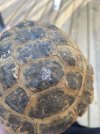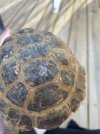Marker9898
New Member
My Russian tortoise, Boris, has a mark on his shell that looks like fungus. It has been developing over a couple of weeks; I only started to notice it in the past three days. I posted these photos to Reddit and overwhelming people said it was fungus or mold. I was recommended to treat the spot with betadine via a toothbrush, scrubbed on the spot daily. A person told me it could take 1-4 weeks of these treatments for the shell to heal. I post this here to ask: is this mark fungus, and do you agree with the recommended treatment? We have called vets, by the way, but it will be a while (possibly two weeks) till we can see them. Thanks
Here are the photos:

Here are the photos:



